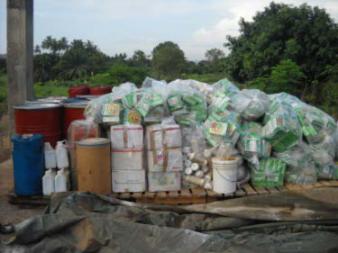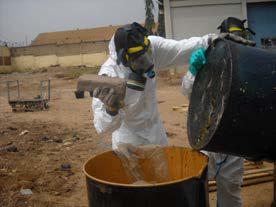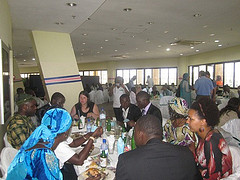 The CropLife CleanFarms Ghana Project began in 2009 after a Memorandum of Understanding between the Government of Ghana, represented by the Ministry of Food & Agiculture (MoFA) and CropLife International, represented by CropLife Ghana (CLG). The project was extensively executed in collaboration with the Ministry of Food & Agriculture and the Environmental Protection Agency (EPA).
The CropLife CleanFarms Ghana Project began in 2009 after a Memorandum of Understanding between the Government of Ghana, represented by the Ministry of Food & Agiculture (MoFA) and CropLife International, represented by CropLife Ghana (CLG). The project was extensively executed in collaboration with the Ministry of Food & Agriculture and the Environmental Protection Agency (EPA).
A total of about 170 MT of obsolete pesticides including its associated waste and empty pesticide containers were realized after the exercise. The materials were collected mostly from stores of agrochemical companies, COCOBOD and Cocoa Inputs, etc. These materials are safely safeguarded and stored at a Temporary Storage Facility (TSF) located at the PPRSD/MoFA, awaiting collection and disposal by FAO.
Apart from this, a pilot container management exercise that began in the Ejura-Sekyere Edumase District of the Ashanti Region is nearing completion. So far, over 6 MT of empty pesticide containers have been lifted from these farming communities in Ejura. The farmers and extension officers in the district were also adequately trained on Safe Uses of Pesticides and Effective Triple Rinsing of empty pesticide containers.
The CleanFarms Ghana Project through its reliable networks, identified a recycling plant, Cyclus Elmina Recycling Plant, situated at Komenda in the Central Region of Ghana, which is licensed to recycle empty pesticide containers. The project has therefore signed a MoU with Cyclus Recycling to recycle all plastic empty pesticide containers from the project. The end product of these pesticide containers would be nondomestic items like pavement blocks, roofing tiles, etc. So far, about 8 MT of empty pesticide containers have been collected by Cyclus from the Temporary Storage Facility (TSF) in Pokuase.
To facilitate the proper recycling of the empty pesticide containers by Cyclus, CropLife Ghana through the project initially processes the containers by triple rinsing them thoroughly using approved chemicals. These containers are then transported to Cyclus and stored in special sheds constructed by CropLife Ghana for only pesticide containers. These are later thoroughly washed and cleansed before recycling.
A total of over US$ 400,000 has been spent on this program so far, and more funds are being committed as at today. Out of this total, CropLife Ghana has contributed over US$ 45,000. Support from CropLife International towards the project has come to an end and CropLife Ghana is taking over the mantle to continue the exercise. There are still an estimated number of over 30 MT of obsolete pesticides available to be safeguarded. These pesticides are located mostly on respective farm plantations and agrochemical companies across the country.
CropLife International (CLI) will continue to contribute (administratively) until the removal of the safeguarded materials to ensure proper management of the stocks. CropLife Ghana therefore needs the support of all and sundry to continue to fund these exercises, including extending the container management program nation-wide.
Downloadable document: A comprehensive report on the Cleanfarms project activities is attached below for free download. It can also be found downloadable on the box.net widget. Enjoy reading!







